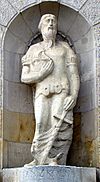John Scolvus facts for kids
Quick facts for kids
John Scolvus
|
|
|---|---|
| Born | about 1435 probably Kolno, Duchy of Masovia
|
| Died | about 1484 |
| Other names | John of Kolno |
| Alma mater | University of Kraków |
| Occupation | Maritime explorer |
John Scolvus (also known as John of Kolno) might have been a sailor in the late 1400s. Some people believe he was one of the first Europeans to reach the Americas in 1476. This would have been before Christopher Columbus. He was supposedly the steersman for an explorer named Didrik Pining. However, there isn't much proof from that time, so we don't know for sure if he really existed or if he reached America.
Contents
Did John Scolvus Discover America?
The Pining Expedition Story
Some stories say that in the 1470s, a group of Danish ships sailed from Norway. They were led by Christian I of Denmark. These ships went west towards Greenland. It's claimed that John of Kolno, a Polish sailor working for the Danish king, was in charge of one of these trips in 1473 or 1476.
The story goes that the fleet was also led by two Baltic sailors, Didrik Pining and Hans Pothorst. A Portuguese explorer, João Vaz Corte-Real, might have joined them too. It's believed they sailed from Greenland's west coast and reached the North American mainland.
However, we can't prove this story today. The only old records we have say that Pothorst and Pining saw a "rocky island called Hvitsark" in 1494. This island was halfway between Iceland and Greenland. This was written by Samuel Eliot Morison in his book "The European Discovery of America, The Northern Voyages."
Was He Real? What the Old Maps Say
It's not clear if John Scolvus truly existed or if he reached America. All the writings that mention him were made much later. Still, some clues suggest he might have sailed in the North Atlantic.
- Gemma Frisius's Globe (1536): A map from 1536 by Gemma Frisius shows an area near the North Pole. It has a note that says, "Quij, the people to whom Joes Scoluss, a Dane, penetrated about the year 1476." This suggests he was from Denmark.
- Francisco López de Gómara's Book (1553): A Spanish writer, Francisco López de Gómara, wrote in his book Historia de las Indias (1553) about a place called Labrador. He said, "Hither also came men from Norway with the pilot [navigator] Joan Scoluo." At that time, Greenland was sometimes called "Labrador" by people in southern Europe.
- Martin Frobisher's Document (1575): A document from about 1575, made for Martin Frobisher's first trip, also mentions John Scolvus. It says, "In the north side of this passage, John Scolus, a pilot of Denmerke, was in anno 1476." This passage refers to a strait that explorers hoped would lead from the Atlantic to the Pacific.
- Michael Lok's Map (1582): An English map from 1582 by Michael Lok shows a land northwest of Greenland. It has the words: "Jac. Scolvus Croetland."
- Cornelius Wytfliet's Book (1597): A writer from Brabant, Cornelius Wytfliet, wrote in 1597 that the northern parts of America were first found by fishermen. He then said that "the honour of its second discovery fell to the Pole Johannes Scoluus (Johannes Scoluus Polonus), who in the year 1476... arrived at the country of Labrador and Estotiland." The word Polonus means "Polish." Some think this was a mistake, and it should have been piloto (pilot).
These later writings about Scolvus might not be fully accurate. The writers probably read earlier accounts and just copied from them.
The Polish Connection

Some historians have wondered if John Scolvus was Polish.
The Polish Theory
Joachim Lelewel (1786 - 1861), a Polish historian, was the first to collect all the mentions of Johannes Scolnus. He found writings from the late 1500s and 1600s that said Scolvus was Polish. Lelewel believed his real name was Jan z Kolna (which means "John of Kolno" in English). He also found records of a Joannis de Colno who studied at the Krakow Academy in 1455. There was also a family of merchants and sailors named Colno or Cholno living in Gdańsk.
Why Some Historians Disagree
Not all historians agree with the Polish theory. Bolesław Olszewicz, a modern historian, says there isn't enough proof that Scolvus was Polish. Most of the books that mention Johannes Scolvus were written more than 100 years after his supposed voyage. No proof from his actual time has been found.
In 1911, Fridtjof Nansen suggested that the word "Pilotus" (pilot) might have been misread as "Polonus" (Polish). This could explain why some sources called him Polish.
See also
 In Spanish: Juan Scolvus para niños
In Spanish: Juan Scolvus para niños

